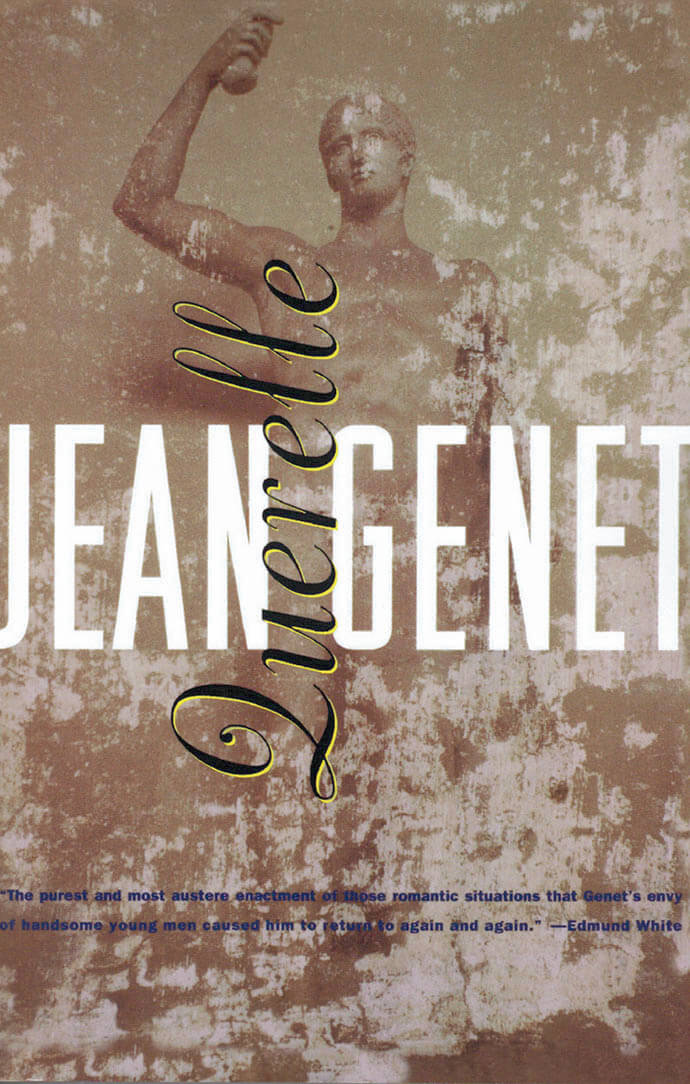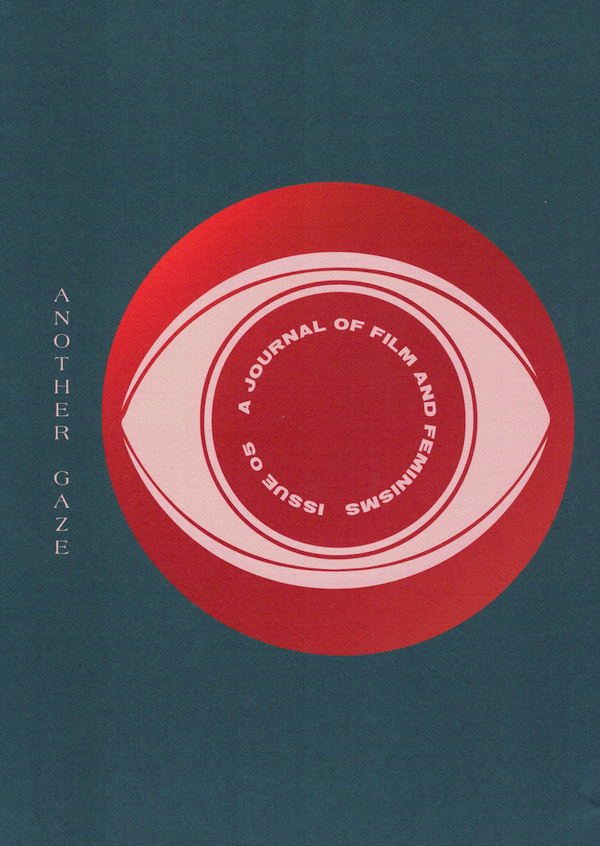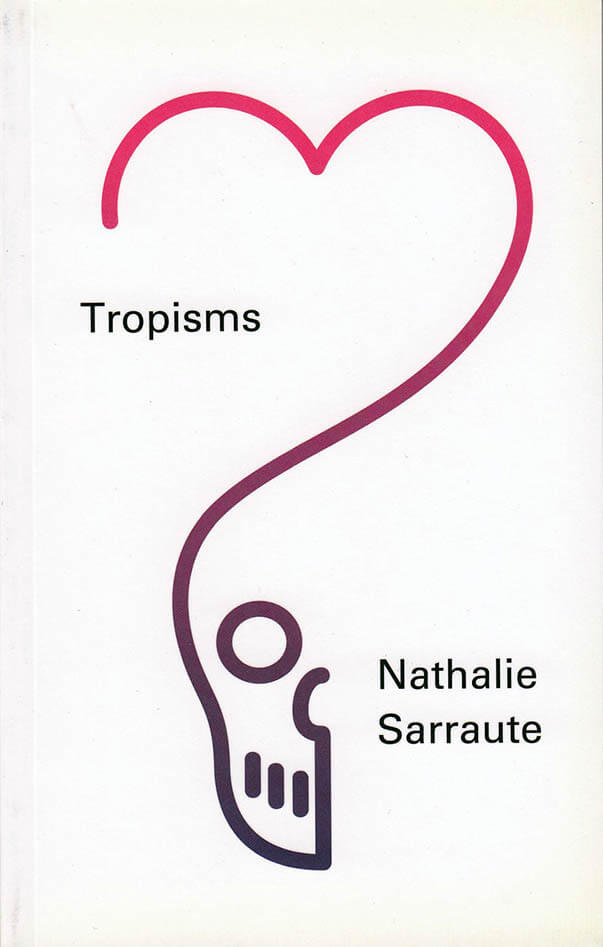Jean Genet
Jean Genet

Querelle
The story of a dangerous man seduced by peril, Querelle deals in a startling way with the Dostoyevskian theme of murder as an act of total liberation.
It is set in the midst of the port town of Brest, where sailors and the sea are associated with murder. Georges Querelle, its protagonist, is a bisexual thief, prostitute and serial killer who manipulates and kills his lovers for thrills and profit. The novel formed the basis for Querelle (1982), Rainer Werner Fassbinder's last film.
And more

Writings and Interviews
The collected writings of artist Marc Camille Chaimowicz, along with the stories behind them told by Alexis Vaillant.
Marc Camille Chaimowicz was an acclaimed visual artist known for his performances, installations and curatorial flair. He was also a writer. This volume, the first comprehensive collection of writings by the artist, includes seminal interviews, chitchats, jokes, performance reports, insightful statements and letters in essay form, as well as rare documents, such as early surviving leaflets, typewriter handouts and hard-to-find articles. Spanning 1971–2023, the book unlocks the work of an artist considered to be a refreshing role model for a new generation of culture mavens and style savants.
Drawing from literature, modernist architecture, interior design, art theory, glam rock and camp culture, the collection reveals the artist's inner self alongside the art, social flânerie and the goings-on of his time. Entertaining and witty, the texts stand out brilliantly with their early acumen and inclusivity, while setting a new template for an expression of queerness through writing. With access to Chaimowicz's personal material and photographs, curator and editor Alexis Vaillant is a guide to the artist's writings. Vaillant provides behind-the-scenes commentary and context—a time capsule of pleasure featuring Andy Warhol, Des Esseintes, Josef Frank, David Bowie, Vito Acconci, Eileen Gray, Alex Kapranos, Jean Cocteau, Elsa Schiaparelli, Jean Genet, Bob Dylan, Emma Bovary and Roger Cook, among others.
Edited by Alexis Vaillant.

Starship 20
Contributors to Starship № 20:
Rosa Aiello, Terry Atkinson, Tenzing Barshee, Gerry Bibby, Mercedes Bunz, David Bussel, Jay Chung, Eric D. Clark, Caleb Considine, Hans-Christian Dany, Albert Dichy, Nikola Dietrich, Martin Ebner, Ruth Angel Edwards, Stephanie Fezer, Jean Genet, Simone Gilges, Julian Göthe, Michèle Graf, Selina Grüter, Ulrich Heinke, Toni Hildebrandt, Beatrice Hilke, Karl Holmqvist, Stephan Janitzky, G. Peter Jemison, Charlotte Johannesson, Julia Jost, Julia Jung, Jakob Kolding, Nina Könnemann, Lars Bang Larsen, Anita Leisz, Norman Lewis, Elisa R. Linn, Sebastian Lütgert, Vera Lutz, Chloée Maugile, Robert McKenzie, Ariane Müller, Christopher Müller, Robert M. Ochshorn, Henrik Olesen, Kari Rittenbach, Nina Rhode, Ulla Rossek, Cameron Rowland, Mark von Schlegell, Ryan Siegan Smith, Philipp Simon, Valerie Stahl Stromberg, Josef Strau, Vera Tollmann, Eleanor Ivory Weber, Camilla Wills, Amelie von Wulffen and Florian Zeyfang.
"This is the 20th issue of Starship and we are proud and very happy to present it, and mainly want to thank all the artists, the contributors, the columnists, and the people who helped us gather images of exhibitions past, and gave us texts from books not yet published. Starship never starts with a clear concept about its future content, or what could be called a theme, but always with a sort of attentive interest. The theme may develop through its columnists—we now think it is easy to distinguish lines of thoughts, images, and texts answering each other. But it surely does so out of this editorial interest that wanders, and finds, and collects, is enthusiastic about artworks, and texts, and people, and then, well, brings this all together in a magazine. This was our working mode during the past year, and the responsiveness of those who regularly write for Starship (the columnists) has shown us that out there others are involved in thoughts that run very much in parallel. It is a strange form, a magazine like this, not getting funded, appearing irregularly, but still following a sort of conventional form that shows its consistency. It is at its core an excess of producing something that might prove itself valuable and liberating in the future."
—Ariane Müller, Henrik Olesen

Whites, Jews, and Us: Toward a Politics of Revolutionary Love
A scathing critique of the Left from an indigenous anti-colonial perspective.
With Whites, Jews, and Us, Houria Bouteldja launches a scathing critique of the European Left from an indigenous anti-colonial perspective, reflecting on Frantz Fanon's political legacy, the republican pact, the Shoah, the creation of Israel, feminism, and the fate of postcolonial immigration in the West in the age of rising anti-immigrant populism. Drawing upon such prominent voices as James Baldwin, Malcolm X, and Jean Genet, she issues a polemical call for a militant anti-racism grounded in the concept of revolutionary love.
Such love will not come without significant discomfort for whites, and without necessary provocation. Bouteldja challenges widespread assumptions among the Left in the United States and Europe—that anti-Semitism plays any role in Arab-Israeli conflicts, for example, or that philo-Semitism doesn't in itself embody an oppressive position; that feminism or postcolonialist theory is free of colonialism; that integrationalism is a solution rather than a problem; that humanism can be against racism when its very function is to support the political-ideological apparatus that Bouteldja names the "white immune system."
At this transitional moment in the history of the West—which is to say, at the moment of its decline—Bouteldja offers a call for political unity that demands the recognition that whiteness is not a genetic question: it is a matter of power, and it is high time to dismantle it.
"Why am I writing this book? Because I share Gramsci's anxiety: "The old are dying and the new cannot be born; in this interregnum a great variety of morbid symptoms appear." The fascist monster, born in the entrails of Western modernity. Of course, the West is not what it used to be. Hence my question: what can we offer white people in exchange for their decline and for the wars that will ensue? There is only one answer: peace. There is only one way: revolutionary love." — from Whites, Jews, and Us
This Semiotext(e)/Intervention series English-language edition includes a foreword by Cornel West.

Our Lady of the Flowers, Echoic
In Our Lady of the Flowers, Echoic, Chris Tysh newly translates Notre-Dame-des-Fleurs, compressing Jean Genet's disturbing 1943 novel into cuttingly charged verse. In the blue hours of the Parisian underworld, pimps, drag queens, and butchers in bloody aprons are joined by Divine, Mignon Dainty-Feet, and the young assassin Our Lady, three saintly figures in a forbidden realm of the senses.
Tysh cuts Our Lady of the Flowers, Echoic into a ghostly song that traces the path from prose to lyric where Divine switches gender and names "as if passing under a scarlet awning." Suturing sexual otherness to an aching of gendered expectations, Tysh's cadences embrace postmodernism's emblematic penchant for all manner of appropriation, and recycling finds a radical iteration in the fashion of fairies, queens, and stool pigeons.
"This volume of verse, played over by a flickering ghostly flame, is perhaps the book that Genet meant to write..."—John Tranter
With an preface by Robert Glück.

Another Gaze Journal 05
Missouri Williams, Daniella Shreir
Including writing about Theresa Hak Kyung Cha, Linda Manz, Sadie Benning, Sarah Maldoror, Cecilia Mangini, Agnes Martin, Peggy Ahwesh, Kira Muratova, Alina Szapocznikow, Jean Genet and more…
On subjects including an interrogation on cinephilia and gender, surveillance, infant observation during the pandemic and the screen as psychic portal, Beirut on film, devotional labour, prisons during lockdown, the notion of solidarity, reproduction and futurity, and much more... Roundtables about Sarah Maldoror; hands and fate, work, pleasure, touch, and surveillance; early women's travel films…
Plus, the year in review…
Featuring writing and contributions by María Palacios Cruz, Lizzie Borden, Kathryn Scanlan, Yasmina Price, Nicolas Russell, Rebecca Liu, Georgie Carr, Pooja Rangan, Jonathan Rosenbaum, Nuotama Bodomo, Phoebe Campion, Janaina Olivera, Cassie da Costa, Frank Beauvais, AS Hamrah, Awa Konaté and many more…

Paraperformance
This first publication brings together texts, documentation, scripts and reference material relating to the body of work Jones started in 2013. Marking a new cycle in his work the book makes a claim about the status of performance in the context of his wider practice and the function of documentation and image regimes in our current times.
The book is claimed to be a form of ‘paraperformance’, meaning a collection of materials that have circulated alongside or chosen to represent the live moments created in his work over a five year period. It represents seven distinct works of installation, sculpture, and performance by Jones including a new work that is made specifically for the pages of this book.
This collection of materials touches on diverse sources and references including the Radical Faerie movement, the Spanish magazine ‘Party’, Liberace’s libel trials, images of uncontacted Amazonian tribes, the political writing of Jean Genet and an early performance work of Vito Acconci to name but a few.
The thread amongst all of the works included in this book is the subtle interweaving of discourses around theatre, performance, the law, representation and politics and the oscillation between urban space, the public sphere and a queer wilderness. More widely the book uses the specificities within Jones’ research to consider the role that performance could play within the art field and, by extension, how documentation and representation of our everyday lives impacts on how we understand our world at large.
This book is part of the series www.anywhereoutofthebook.com series

Ghost Image
Ghost Image is made up of sixty-three short essays—meditations, memories, fantasies, and stories bordering on prose poems—and not a single image. Hervé Guibert's brief, literary rumination on photography was written in response to Roland Barthes's Camera Lucida, but its deeply personal contents go far beyond that canonical text. Some essays talk of Guibert's parents and friends, some describe old family photographs and films, and spinning through them all are reflections on remembrance, narcissism, seduction, deception, death, and the phantom images that have been missed.
Both a memoir and an exploration of the artistic process, Ghost Image not only reveals Guibert's particular experience as a gay artist captivated by the transience and physicality of his media and his life, but also his thoughts on the more technical aspects of his vocation. In one essay, Guibert searches through a cardboard box of family portraits for clues—answers, or even questions—about the lives of his parents and more distant relatives. Rifling through vacation snapshots and the autographed images of long-forgotten film stars, Guibert muses, "I don't even recognize the faces, except occasionally that of an aunt or great-aunt, or the thin, fair face of my mother as a young girl." In other essays, he explains how he composes his photographs, and how—in writing—he seeks to escape and correct the inherent limits of his technique, to preserve those images lost to his technical failings as a photographer.
With strains of Jean Genet and recurring themes that speak to the work of contemporary artists across a range of media, Guibert's Ghost Image is a beautifully written, melancholic ode to existence and art forms both fleeting and powerful—a unique memoir at the nexus of family, memory, desire, and photography.
Hervé Guibert (1955-91) was born and worked in Paris. A noted photographer, he also contributed articles on culture to the French newspaper Le Monde and wrote works of fiction and books on photography.

Tropisms
Nathalie Sarraute's Tropisms is considered one of the defining texts of the nouveau roman movement. Tropisms was championed as a masterpiece by Jean Genet, Marguerite Duras, and Jean-Paul Sartre, who hailed Sarraute as his favorite "anti-novelist." Sarraute defined her Tropisms as the "movements that are hidden under the commonplace, seemingly harmless instances of our everyday lives." Like figures in a grainy and shadowy photo, the characters in Tropisms are barely defined, the narrative never developed beyond a stressed moment. Instead, Sarraute brilliantly highlights the shift in tone through remarks or subtle details when a relationship changes, when we fall slightly deeper into or begin to emerge out of love or trust, or when something innocent tilts by the smallest degree toward suspicion.
Tropisms—something like 'prose poems'—as Sarraute calls them that— this is her form! Her texture is anti-novelistic, though she's decided to write 'novels' and launched an important critique of the novel on the basis of her method.—Susan Sontag
Translated by Maria Jolas.
Published 2015.

Index Cards: Selected Essays
In these essays, the acclaimed artist, photographer, writer, and filmmaker Moyra Davey often begins with a daily encounter, with a photograph, a memory, or a passage from a book, and links that subject to others, drawing fascinating and unlikely connections, until you can almost feel the texture of her thinking.
While thinking and writing, she weaves together disparate writers and artists, Mary Wollstonecraft, Jean Genet, Virginia Woolf, Janet Malcolm, Chantal Akerman, and Roland Barthes, among many others, in a way that is both elliptical and direct, clearheaded and personal, prismatic and self-examining, layering narratives to reveal the thorny but nourishing relationship between art and life.
Published May 2020.